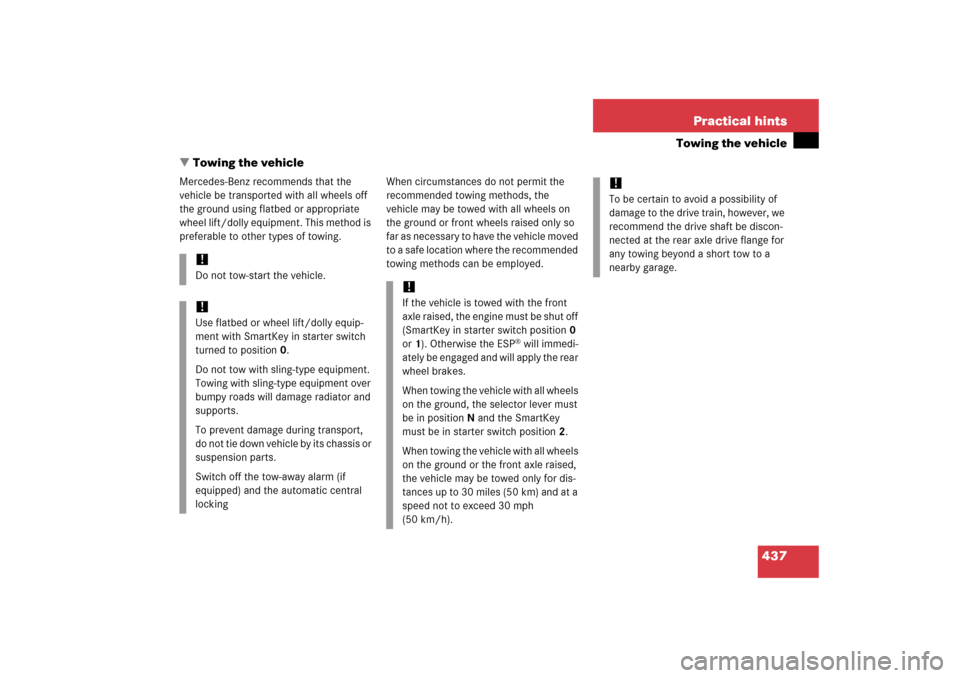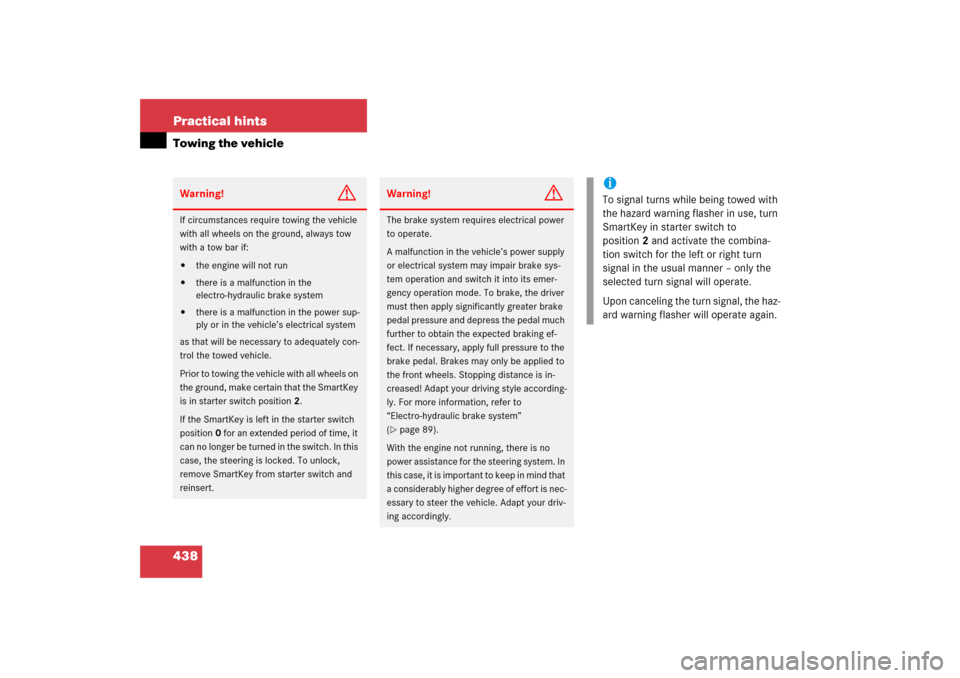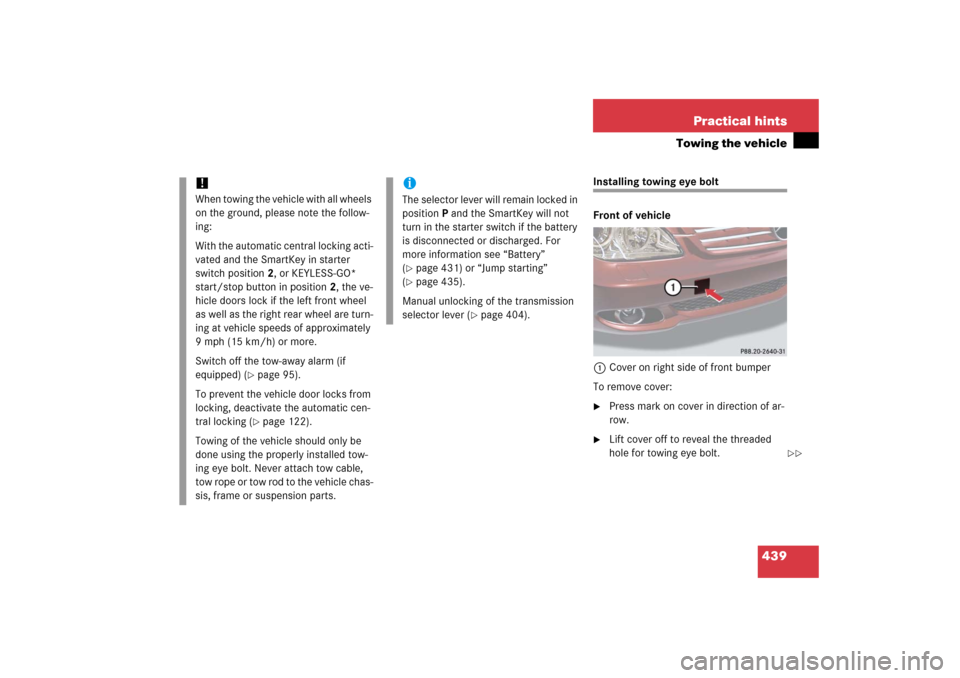Page 352 of 498
351 Practical hints
What to do if …
Where will I find ...?
Unlocking/locking in an emergency
Opening/closing in an emergency
Resetting activated head restraints
Replacing SmartKey batteries
Replacing bulbs
Replacing wiper blades
Flat tire
Battery
Jump starting
Towing the vehicle
Fuses
Page 378 of 498

377 Practical hints
What to do if …
Display symbol
Display messages
Possible cause/consequence
Possible solution
(USA only);(Canada only)3
Brake fluid
Visit workshop
There is insufficient brake fluid in the
reservoir.
�
Risk of accident! Stop the vehicle in a
safe location and notify an authorized
Mercedes-Benz Center. Do not add
brake fluid! This will not solve the
problem.
Warning!
G
Driving with the messages “Brake fluid Visit
workshop” displayed can result in an acci-
dent. Have your brake system checked im-
mediately.
If there is a malfunction in the
electro-hydraulic brake system, we recom-
mend that the vehicle be transported with
all wheels off the ground using flatbed or ap-
propriate wheel lift/dolly equipment.
A tow bar must be used if circumstances do
not permit the use of the recommended
towing methods and the vehicle requires
towing with all four wheels on the ground.
Towing the vehicle with all four wheels on
the ground is only permissible for distances
up to 30 miles (50 km) and at a speed not to
exceed 30 mph (50 km/h). For more infor-
mation, refer to “Towing the vehicle”
(�page 437).
If the electro-hydraulic brake system enters
its emergency operation mode, the driver
must apply significantly greater brake pedal
pressure and depress the pedal much fur-
ther than normal to obtain braking effect. If
necessary, apply full pressure to the brake
pedal. Brakes may only be applied to the
front wheels. Stopping distance is in-
creased!
Do not add brake fluid before checking the
brake system. Overfilling the brake fluid res-
ervoir can result in spilling brake fluid on hot
engine parts and the brake fluid catching
fire. You can be seriously burned.!If you find that the brake fluid in the
brake fluid reservoir has fallen to the
minimum mark or below, have the
brake system checked for brake pad
thickness and leaks.
Page 400 of 498

399 Practical hints
Where will I find ...?
Removing the spare wheel�
Turn luggage bowl counterclockwise.
�
Remove spare wheel2.
Storing the spare wheel
�
Place spare wheel2 in wheel well.
�
Turn luggage bowl clockwise to its stop
to secure the spare wheel.
Vehicle tool kit
The vehicle tool kit is stored in the com-
partment underneath the trunk floor
(�page 398).
The vehicle tool kit includes:
�
One pair of universal pliers
�
One towing eye bolt
�
One wheel wrench
�
One alignment bolt
�
One fuse extractor
�
One collapsible wheel chock
�
Spare fusesVehicle jack
!Always lower trunk floor before closing
the trunk.iVehicles with collapsible tire:
The electrical air pump is located under
the luggage bowl3.
Warning!
G
The jack is designed exclusively for jacking
up the vehicle at the jack take-up brackets
built into both sides of the vehicle. To help
avoid personal injury, use the jack only to lift
the vehicle during a wheel change. Never
get beneath the vehicle while it is supported
by the jack. Keep hands and feet away from
the area under the lifted vehicle. Always
firmly set parking brake and block wheels
before raising vehicle with jack.
Do not disengage parking brake while the
vehicle is raised. Be certain that the jack is
always vertical (plumb line) when in use, es-
pecially on hills. Always try to use the jack
on a level surface. Make sure the jack arm is
fully seated in the jack take-up bracket.
Always lower the vehicle onto sufficient
capacity jackstands before working under
the vehicle.
Page 438 of 498

437 Practical hints
Towing the vehicle
�Towing the vehicle
Mercedes-Benz recommends that the
vehicle be transported with all wheels off
the ground using flatbed or appropriate
wheel lift/dolly equipment. This method is
preferable to other types of towing.When circumstances do not permit the
recommended towing methods, the
vehicle may be towed with all wheels on
the ground or front wheels raised only so
far as necessary to have the vehicle moved
to a safe location where the recommended
towing methods can be employed.
!Do not tow-start the vehicle.!Use flatbed or wheel lift/dolly equip-
ment with SmartKey in starter switch
turned to position0.
Do not tow with sling-type equipment.
Towing with sling-type equipment over
bumpy roads will damage radiator and
supports.
To prevent damage during transport,
do not tie down vehicle by its chassis or
suspension parts.
Switch off the tow-away alarm (if
equipped) and the automatic central
locking
!If the vehicle is towed with the front
axle raised, the engine must be shut off
(SmartKey in starter switch position0
or1). Otherwise the ESP
® will immedi-
ately be engaged and will apply the rear
wheel brakes.
When towing the vehicle with all wheels
on the ground, the selector lever must
be in positionN and the SmartKey
must be in starter switch position2.
When towing the vehicle with all wheels
on the ground or the front axle raised,
the vehicle may be towed only for dis-
tances up to 30 miles (50 km) and at a
speed not to exceed 30 mph
(50 km/h).
!To be certain to avoid a possibility of
damage to the drive train, however, we
recommend the drive shaft be discon-
nected at the rear axle drive flange for
any towing beyond a short tow to a
nearby garage.
Page 439 of 498

438 Practical hintsTowing the vehicleWarning!
G
If circumstances require towing the vehicle
with all wheels on the ground, always tow
with a tow bar if:�
the engine will not run
�
there is a malfunction in the
electro-hydraulic brake system
�
there is a malfunction in the power sup-
ply or in the vehicle’s electrical system
as that will be necessary to adequately con-
trol the towed vehicle.
Prior to towing the vehicle with all wheels on
the ground, make certain that the SmartKey
is in starter switch position2.
If the SmartKey is left in the starter switch
position0 for an extended period of time, it
can no longer be turned in the switch. In this
case, the steering is locked. To unlock,
remove SmartKey from starter switch and
reinsert.
Warning!
G
The brake system requires electrical power
to operate.
A malfunction in the vehicle’s power supply
or electrical system may impair brake sys-
tem operation and switch it into its emer-
gency operation mode. To brake, the driver
must then apply significantly greater brake
pedal pressure and depress the pedal much
further to obtain the expected braking ef-
fect. If necessary, apply full pressure to the
brake pedal. Brakes may only be applied to
the front wheels. Stopping distance is in-
creased! Adapt your driving style according-
ly. For more information, refer to
“Electro-hydraulic brake system”
(�page 89).
With the engine not running, there is no
power assistance for the steering system. In
this case, it is important to keep in mind that
a considerably higher degree of effort is nec-
essary to steer the vehicle. Adapt your driv-
ing accordingly.
iTo signal turns while being towed with
the hazard warning flasher in use, turn
SmartKey in starter switch to
position2 and activate the combina-
tion switch for the left or right turn
signal in the usual manner – only the
selected turn signal will operate.
Upon canceling the turn signal, the haz-
ard warning flasher will operate again.
Page 440 of 498

439 Practical hints
Towing the vehicle
Installing towing eye bolt
Front of vehicle
1Cover on right side of front bumper
To remove cover:�
Press mark on cover in direction of ar-
row.
�
Lift cover off to reveal the threaded
hole for towing eye bolt.
!When towing the vehicle with all wheels
on the ground, please note the follow-
ing:
With the automatic central locking acti-
vated and the SmartKey in starter
switch position2, or KEYLESS-GO*
start/stop button in position2, the ve-
hicle doors lock if the left front wheel
as well as the right rear wheel are turn-
ing at vehicle speeds of approximately
9 mph (15 km/h) or more.
Switch off the tow-away alarm (if
equipped) (
�page 95).
To prevent the vehicle door locks from
locking, deactivate the automatic cen-
tral locking (�page 122).
Towing of the vehicle should only be
done using the properly installed tow-
ing eye bolt. Never attach tow cable,
tow rope or tow rod to the vehicle chas-
sis, frame or suspension parts.
iThe selector lever will remain locked in
positionP and the SmartKey will not
turn in the starter switch if the battery
is disconnected or discharged. For
more information see “Battery”
(�page 431) or “Jump starting”
(�page 435).
Manual unlocking of the transmission
selector lever (
�page 404).
��
Page 441 of 498
440 Practical hintsTowing the vehicleThe towing eye bolt is supplied with the
tool kit (located in the storage compart-
ment under the trunk floor).�
Screw towing eye bolt in to its stop and
tighten with lug wrench.
To reinstall cover:
�
Fit cover and snap into place.
Rear of vehicle
2Cover on right side of rear bumperTo remove cover:
�
Press mark on cover in the direction of
the arrow.
�
Fold cover down to reveal the threaded
hole for the towing eye bolt.
The towing eye bolt is supplied with the
tool kit (located in the storage compart-
ment under the trunk floor).
�
Screw towing eye bolt in to its stop and
tighten with lug wrench.
To reinstall cover:
�
Fit cover and snap into place.
��
Page 487 of 498

486 IndexHood 293
Message in display 384
HVAC see 4-zone automatic climate
control
Hydroplaning 283
I
Identification labels 446
Identification Number, Vehicle (VIN) 446
Ignition 36, 38, 50
Immobilizer 93
Indicator lamps see Lamps, indicator and
warning
Infant and child restraint systems see
Children in the vehicle
Information
About service and warranty 10
Button for Tele Aid 267
Inside door handle 111
Inside rear view mirror
Antiglare 191Installing
Infant and child restraint systems 80
Towing eye bolt 439
Wiper blades 418
Instrument cluster 24, 144, 474
Cleaning 349
Coolant temperature gauge 145
Illumination 144
Multifunction display 147
Outside temperature indicator 146
Interior lighting 141
Delayed switch-off 167
Interior rear view mirror 44
J
Jack 398, 399
Jacking up the vehicle 425
Jump starting 435K
Key, Mechanical 402
Key, SmartKey
Changing batteries 408
Key, SmartKey with KEYLESS-GO*
Changing batteries 409
KEYLESS-GO* 110, 474
Activating ignition with 38
Closing
Trunk 117
Factory setting 107
Global locking 107
Global unlocking 107
Important notes 105
Remote controls 103
Starting the engine 50
Turning off engine 60
Unlocking and opening, trunk 110
Unlocking with 35
Kickdown 180, 474
Kilopascal 333